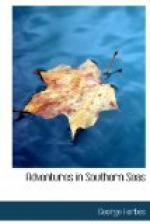I found my old commander in the cabin of the “Santa Isabel”, an ancient Spanish vessel, reported to have voyaged to the south in 1595, when Mendana, a Spaniard, was sent out with instructions to establish a colony at the island of San Christobal, in the Solomon Group, and from thence to make an attempt to discover the Great Southern Continent. Mendana’s fleet consisted of three large vessels and a frigate, and, since it was intended to settle a colony, many took their wives with them, among the emigrants being Mariana, the wife of Lope de Vega, who commanded the “Santa Isabel”. The total number of men in the fleet was 378, of whom 280 were soldiers. The “Santa Isabel” became detached from the rest of the fleet, and reached the Great South Land, where she spent five years in a harbour said to be of great beauty and extent—the finest harbour in the world.
All this we learnt, from the log of the “Santa Isabel”, though what became of the expedition, or of those who composed it, the record did not disclose. But the reading which interested Hartog most, keen treasure-hunter that he continued to be, was a paper describing some curious drawings he had found in one of the lockers of the vessel, of hands, some with six fingers, some with four, and others with only two. Under these drawings was the following inscription, translated into Spanish from some ancient language: “These hands are not carved upon the rocks, but are painted with a pigment that withstands the elements, and yieldeth not to time. They mark the measures of gold obtained.” Then followed a rude chart giving the latitude and longitude of the place which Hartog professed his ability to find.
“Join me, Peter,” he said, “and let us ship together. There’s treasure to be won, dangers to be passed, and forgetfulness to be had in the South. You are still a young man—in your prime. Is it fair that you should set yourself against that which plainly hath been decreed by Fate?”
These words of Hartog moved me, as well they might, and I placed myself unreservedly in his hands. My father-in-law, when he was made acquainted with my desire to embark upon another voyage, offered no opposition. He was, I imagine, glad to be rid of me, perceiving that my moods ashore might interfere with the plans he had formed for the management of my estates. So, all being settled to our mutual satisfaction, Hartog and I went to work to equip our vessel, in which occupation I found relief from my sorrow, and became more reconciled to submit myself to the will of heaven.
In three weeks our preparations were completed. A new ship was purchased, and commissioned without regard to cost. So much money was spent upon her that Hartog called her the “Golden Seahorse”. She carried six guns, and a brass bow-chaser, with which Hartog declared we might make war upon the whole South Pacific in the event of our being forced to hostilities. A great quantity of arms and ammunition was put aboard, together with a supply of beads, knives, and bright-coloured cloths to barter with the natives. Berths were also found for Bantum and Janstins in the officers’ quarters, and although Hartog and I were joint owners of the “Golden Seahorse”, and shared equally in the profit or loss of the expedition, Hartog was given the supreme command.




